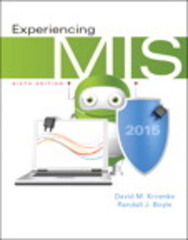Question
1. Please edit the paper below. 2. Check for Grammer, and flow so it makes sense. 3. Also, if you can edit so it won't
1. Please edit the paper below.
2. Check for Grammer, and flow so it makes sense.
3. Also, if you can edit so it won't sound so redundant (if it does) please re-word.
4. Add paragraph breaks
5. Does my paper overall makes sense
According to Weber rationalization was so harmful for a number of reasons. He believed that rationalization would result in a "iron cage" of regulations and bureaucracy, limiting individual freedom and resourcefulness. Disenchantment, the word Weber used to describe a world full of calculated, predictable processes, was something that rationalization could lead to. It was harmful because he thought, people would feel less individualistic and stuck in a system that prioritizes efficiency above humanistic attributes.
I am imprisoned in the iron cage in many aspects of my life: to name a few, access to healthcare, resources for my son that has autism, and school polices that many times lack needed resources for children with autism or disabilities in general.
When it comes to access to healthcare, the healthcare system is often heavily bureaucratized. In my experience, that has led to difficulties in accessing care in a prompt timeframe. This has been due to the need to navigate complex systems of insurance and specialist referrals in some instances. In past experiences I have often struggled to get affordable access to healthcare for me and my family because of difficulties of navigating through a maze of paperwork, assessments, and eligibility criteria to access healthcare.
Similarly, resources for my son that has autism are also heavily bureaucratized. In my experience, receiving access to resources that he needs many times has not been easily accessible due to the cost and access of resources. For example, the cost of resources he has needed many times has beenoverlooked, restricting the access to needed services. For instance, when my son turned 3 years old, he was discontinued from receiving occupational therapy services. I was told that services were discontinued because he had sufficient progress to keep progressing and that other children would benefit more. In order for my son to continue, getting occupational services I had to get him evaluated once again by his the occupational therapist at the pre-school he attended. He eventually qualified to continue services but it was difficult to accomplish. In my son's example, he was discontinued from receiving services because the system determined that he had made sufficient progress and that other children would benefit more. This decision was made based on a calculation of need and benefit, rather than on my son's individual circumstances. In order for my son to continue receiving services, I had to get him re-evaluated. This is another example of the system's emphasis on efficiency and calculability. Rather than considering my son's individual needs, the system required a formal evaluation to determine his eligibility. Despite eventually qualifying for services, the process was difficult and time-consuming. This reflects the "cage" aspect of Weber's concept, despite my efforts, meand my son are trapped within a system that prioritizes efficiency and calculability over individual needs.
I think there are advantages of increasing rationality.
"Increasing rationality" does have advantages. Many times it can result in improved decision-making, more effective and efficient systems, and a deeper comprehension of the outside environment but with this its important to strike a balance between this and an understanding of uniqueness, and the unpredictable nature of being human. Regarding breaking free from the iron cage, Weber believed that rationalization was a process that was almost unavoidable. To combat the adverse effects of rationalization, finding ways to humanize bureaucratic processes or striking a balance between rational systems and individual freedom can provide a more balanced approach that acknowledges the unpredictability of rational. This might entail designing systems that allow for individual flexibility and creativity while yet being logical, effective, and flexible.
Step by Step Solution
There are 3 Steps involved in it
Step: 1

Get Instant Access to Expert-Tailored Solutions
See step-by-step solutions with expert insights and AI powered tools for academic success
Step: 2

Step: 3

Ace Your Homework with AI
Get the answers you need in no time with our AI-driven, step-by-step assistance
Get Started


